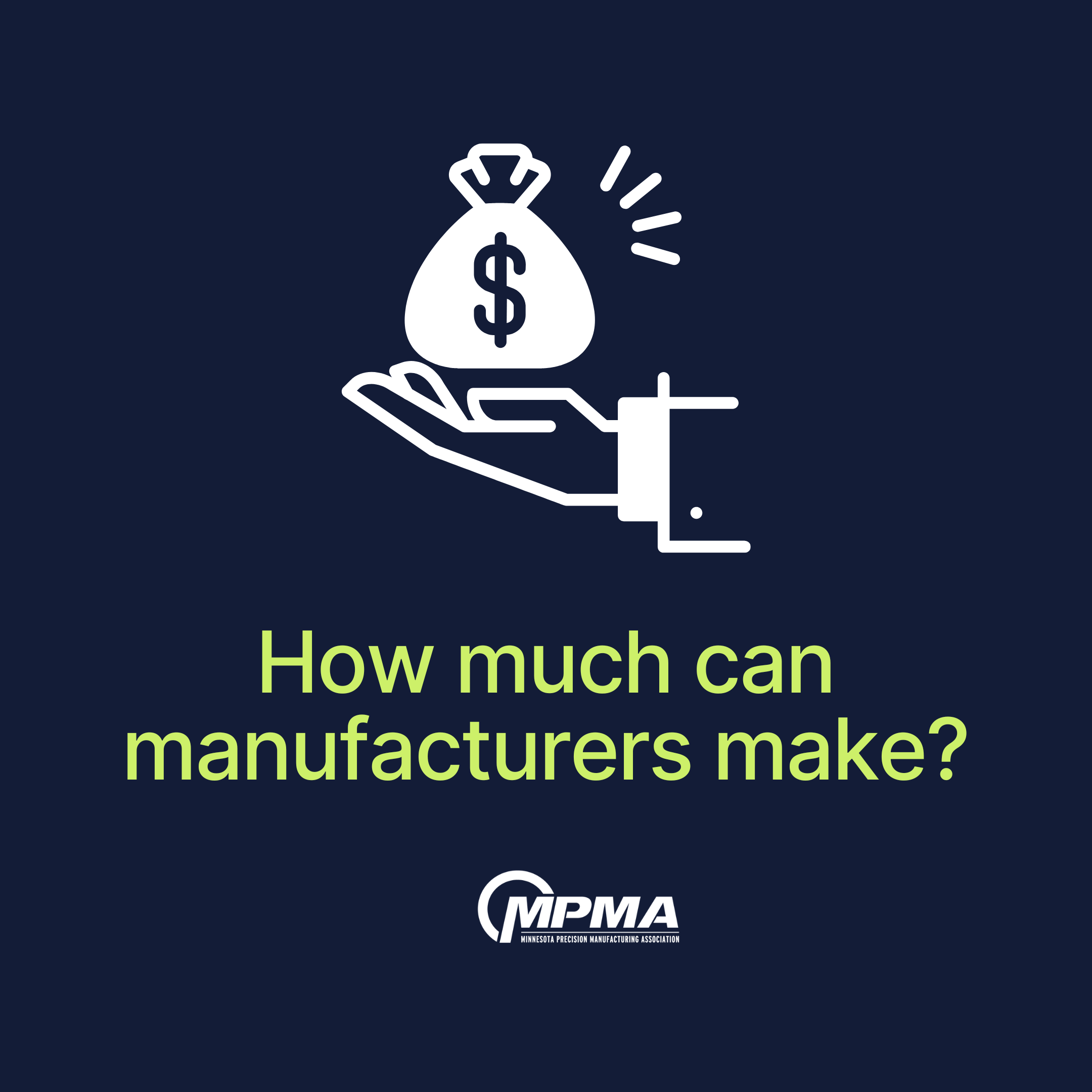
How much can manufacturers make?
You’ve probably heard that manufacturing is a high-paying field with strong growth opportunities for the future. But everyone has a different definition of “high-paying” — so just what is the earning potential for a career in precision manufacturing?
The true answer is that it depends. In any field, there are a variety of factors that will impact how much you actually make. For one thing, the amount of student debt you have after graduation will impact your take-home pay. But your salary will also depend on the amount of experience you bring to a job, and the overall potential of your specific niche.
There’s a reason our industry has low turnover rates and high employee tenure over time. In this post, we’re breaking down some of the top factors that will impact how much you make in a career in manufacturing — and illustrate why it just might be the industry for you.
The student debt problem
It’s no secret that there’s a crushing student loan debt problem in the United States.
Over the past 30 years, the cost of college tuition has doubled compared to the rate of inflation. According to Forbes, the average tuition cost has risen to $10,740 per year for public four-year institutions and $38,070 for private ones. With over $1.75 trillion in total student loan debt, 55% of students from public four-year institutions and 57% of those from private ones have some form of student debt.
According to a survey of 61,000 individuals by Research.com, it takes borrowers an average of 20 years to pay off their debt.
Is the panic starting to set in? We’re here to stop you in your tracks with some good news. Thankfully, you don’t have to get a four-year degree to have a successful and lucrative career, which has always been the case for the manufacturing industry. There are many options for two-year Associate’s degree programs or even certificates and diplomas that can get you an entry-level position in the manufacturing niche of your choosing.
Plus, our industry is always on the lookout for new talent — your fresh ideas and desire to gain experience are currently in high demand. There are lots of employers who will pay for on-the-job training to get you in the door and some go as far as paying for your education or providing you with tuition reimbursement.
There’s a place in manufacturing for you
Whether you’re interested in working with your hands or managing people, you can find a place in the manufacturing industry.
Check out just a few of the top specializations in our industry right now (according to the Minnesota Department of Employment and Economic Development [DEED]) and the qualifications you need to get there.
|
THE JOB |
YOU’LL LIKE THIS JOB IF . . . |
AVG HOURLY WAGE |
ENTRY-LEVEL QUALIFICATIONS |
CAREER OUTLOOK |
|
Assemblers/ Fabricators |
You get satisfaction from sorting pieces of a puzzle to see a finished product. |
($37,440-$49,920 annually) |
High school diploma or equivalent combined with on-the-job training from employer |
Above average demand; 4,582 job openings predicted over next 10 years |
|
Tool and Die Workers |
You enjoy the idea of creating something from raw materials. |
($49,920-$79,960 annually) |
High school diploma or equivalent; some level of education through community college, trade school or apprenticeship. |
Average demand; 1,874 job openings expected over the next 10 years |
|
CNC Operators |
You enjoy working with technology and with your hands. |
($41,600-$60,320 annually) |
Some employers may require a degree, certification or diploma. |
High demand; 5,419 job openings expected over the next 10 years. |
|
Welders, Cutters, Solderers and Brazers |
You have a passion for making things look like new. |
($47,840-$62,400 annually) |
High school diploma or equivalent combined with on-the-job training from employer; a degree, certificate or diploma will set you apart |
High demand; over 11,000 job openings expected over the next 10 years |
|
First-line Production Supervisors |
You like working with people and leading teams. |
($58,240-$83,200 annually) |
High school diploma or equivalent; some level of education through community college, trade school or apprenticeship. |
High demand; 12,276 openings predicted in the next 10 years |
Reminder: these are median salaries and does not include employee benefit packages such as healthcare, 401K, paid time off, etc. As you gain experience and tenure with an employer, your earning potential will rise, along with the benefits of working in a stable, in-demand industry. Plus, with a relatively low barrier to entry, manufacturing is a smart choice for reducing student debt so you can take more of your hard-earned pay home and support your life, especially for young adults.
If you’re interested in kickstarting your career in manufacturing, our workforce page is a great place to start. There, you’ll find educators and employers in Minnesota who are looking for motivated, hardworking individuals like you who are ready to become the future faces of manufacturing.
January 26, 2024


.png?width=240&height=400&name=VisionOne%20Portrait%20Ad%20(240%20x%20400%20px).png)
.png?width=240&height=400&name=2025%20Lube%20Tech%20Vertical%20Ad%20(240%20x%20400%20px).png)
